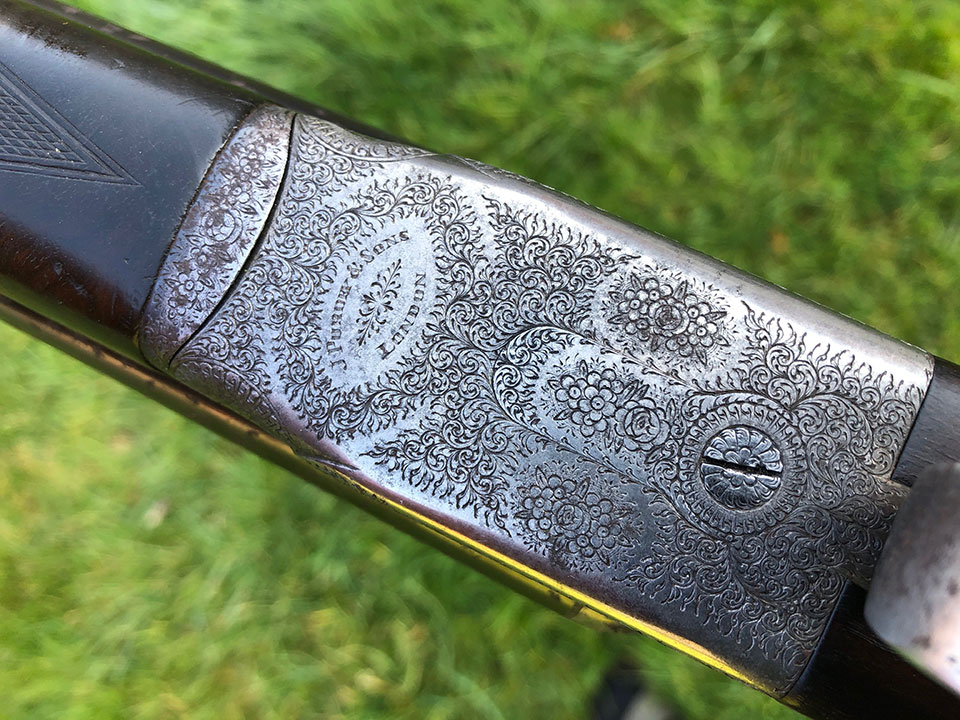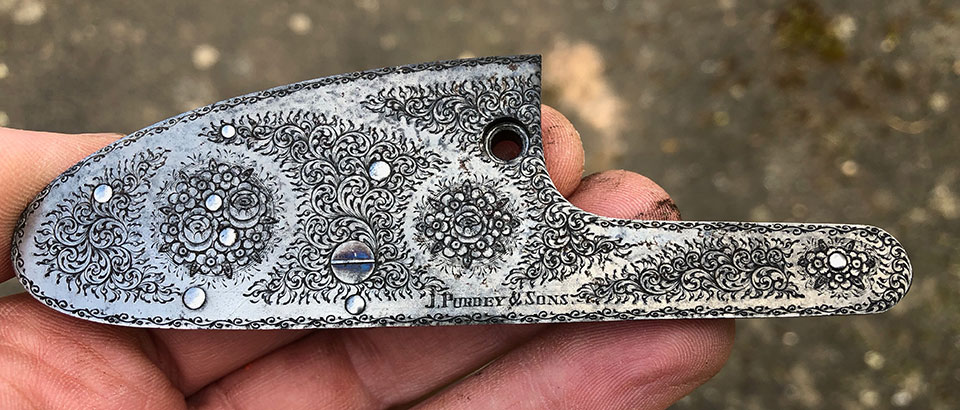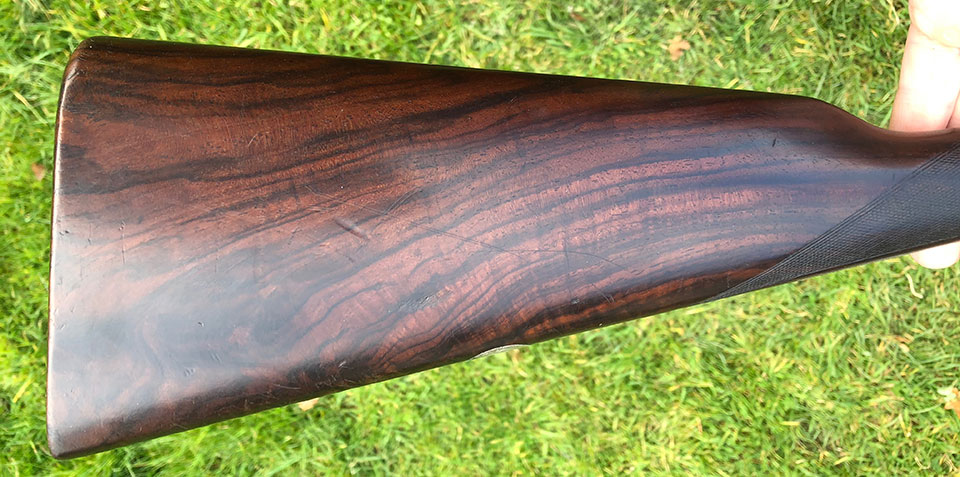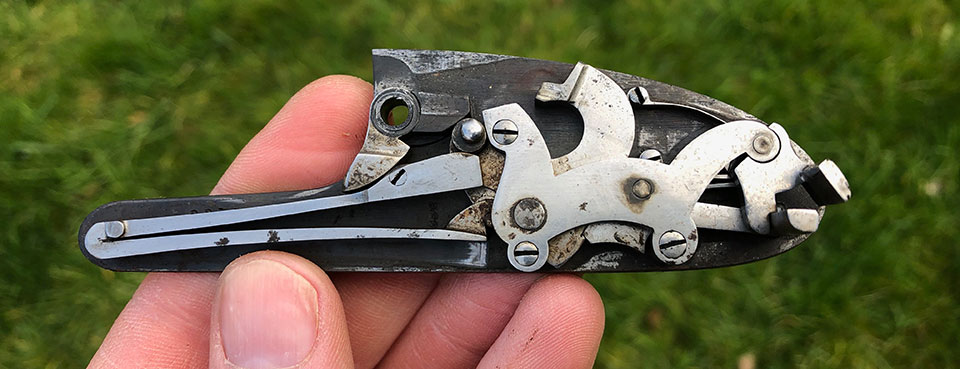The gun in focus here arrived with a story, as they so often do. Made in 1921 as No.4 of a garniture, this Purdey was inherited by a chap who was destined for a year abroad, in Australia. Before leaving, he and a friend went for a last bit of rough shooting. After they had finished, the gun was sleeved, and put under the bed.
Fifteen years later, the gap-year had turned into a new life and provided a new Aussie wife, when a sad duty to return home and attend his father’s funeral brought the owner back to England.
The two friends who had shot together on that last weekend all those years ago met again at the funeral and the owner asked his friend if he still had a shotgun certificate. The answer was met with the offer of the Purdey as a gift. The owner’s licence had long since lapsed and he was returning to Australia the next day. “You can have it, it is still under the bed”.
Under the bed it was, exactly where it had been put, wet, after that day out shooting, fifteen years ago. Unsurprisingly, it was rusty and looking a bit sorry for itself. But hey, it was a free Purdey! The new owner oiled it and rubbed off the worst of the rust. He then put it in his cabinet.
A little while later he was on his way to the river bank to catch a fish, when he suffered a heart attack, fell, hit his head on a rock and died shortly afterwards. His widow gave the gun to a family friend and asked him to sell it. It was offered to a friend of mine, who declined and thereafter, it came to me.
What a journey these old guns make, outlasting owner after owner yet somehow remaining valued and useful to someone further along the line. Having taken custodianship, it fell to me to formulate a plan for refurbishment. Can I bring Purdey No. 22,144 back to its former glory?
Establishing what one has, is a good starting point and I found out 22,144 was made in 1921 as the last gun in a set of four, known in the trade as a ’garniture’. It is the classic game gun of its day. The 1920s Purdey is a svelte, well-refined thoroughbred. It pre-dates the wall street crash and was made at a time when Purdey workers were long-serving and experienced in making the signature side-lock; Beesley’s 1880 patent self-opener. The 29” chopper-lump, steel barrels were a popular length, perhaps more often seen on Woodwards than Purdeys but making the gun a little lighter and faster than the older 30” guns.
The bar is slightly rounded-off, again, losing a little weight and making the gun sleek and flowing in line from butt to muzzle. The stock is classic London best from a period when good walnut was readily available. Dark of figure, with black lines running from comb to toe, it enhances the visual flow and brings the entire gun together perfectly.
Unusually for the period, it has a long length of pull; just over 15” to centre and no additional butt plates or pads. People were generally shorter then but the original owner must have been six feet, or more, in height. Weight is a lively, but not uncomfortably light, 6lbs 8 1/2 oz. It balances 1/2” from the centre of the hinge pin, which is typical for a Purdey game gun and has 1/2" of cast off.
Engraving is typical Purdey rose and scroll, but by this time the size had increased from the ultra-fine bouquets and tiny scrolls originated by James Lucas in the 1880s and ‘90s. Fences are beaded and similarly engraved. I can’t help but note that while the bouquets and scrolls are nicely executed, the name ‘J. Purdey & Sons’ is squeezed into a space almost as an afterthought, not incorporated into the overall design layout.
Removing the locks reveals the presence of Purdey’s second type of intercepting safety, the ‘safety locking sear’, designed by Ernest Lawrence and used from the 1920s until the 1980s. The earlier version of intercepting safety was probably the better one but the new type was more suited to working with single triggers.
The gun is all classic Purdey, there is nothing unusual about the it; it just exudes taste, quality and accomplishment. Truly, the very best game gun available at the time from a team of gunmakers at the peak of their prowess. It cost £92.8s 0d. That figure represented the equivalent of about fifteen weeks’ wages for a Purdey barrel maker. A Crossley Model 20/70 motor car cost £845, by comparison.
Not that the 1920s started well for Purdey, orders were around 200 per annum rather than the 300 per annum of the pre-war years. Harry Lawrence completed his apprenticeship in 1921, beginning a hugely influential career at the firm. During this period, Purdey began making inroads into the lucrative American market and developed their first over & under model.
However, the gun appears to have been made for an Englishman; Lt. Col. George Philippi, who was a friend and good customer of Tom Purdey. No.22144 was made to create a fourth gun to be added to a trio delivered in August 1921. The serial number was given to it perhaps as a special favour to provide a sequential numbering to the guns. There are, in fact, two Purdey guns with serial No.22144; the other one is a lightweight 28" barreled 12-bore with a 14 1/4" stock. George Philippi lived at Crawley Court and is buried in Crawley Cemetary. He died, aged just 43, in 1933. Col. Philippi distinguished himself in the First World War, winning the Military Cross for shooting down an enemy balloon while serving in the Royal Flying Corps.
All four guns in the sequence, 22141, 22142, 22143 and 22144 have rounded bars and stocks a fraction over 15" to centre, cast off 1/2", and weighing 6lbs 8 1/2oz.
It is the practice at Purdey for some of the gunmakers to mark their work with their initials. The ‘BD’ on the forend iron shows that it was actioned by Ben Delay and the barrels were made by Sam Simons, as denoted by the feint ‘SS’ on the tube under the forend.

The gun does need some care and attention but it has not been ruined by bad gun-smithing or outright shot-to-bits, like some are. Most of the pin and screw slots line up correctly and are not burred or enlarged. The metal parts have never been polished or re-finished and the stock has never been re-finished.
The chequer is worn almost smooth at the hand but the pattern is visible and drop points are in good shape. The wood stands proud of the metal almost everywhere - around the locks and action, the forend iron etc. A gentle re-finish to remove dents and scratches, revive the colour and finish will have it looking superb.
The barrels need to be lightly struck up and polished, then blacked, with the engraving lightly picked-out where the address is engraved on the rib. The flats bear the proof marks from the last, and only time, the gun was re-proofed; to .740”, in London. Chambers remain the original 2 1/2” in length and the barrel walls are a reasonable 21 thou’ minimum in both, with nice clean bores and chambers, no dents or rivels and the ribs sound and ringing like a bell.
It does need a thorough strip, clean and service of the mechanism and re-jointing, though it is not apparently loose when assembled; Purdeys usually feel tight because of the spring tension on the barrels from the self-opening kickers. Sure enough, having removed the locks and boiled off the grime, they came up nicely but revealed barrels loose on the action. Behind the lock plates, the inletting work was still sharp and the wood in good condition, though a little darkened with oil. Strikers were gold-washed and the bridle and springs burnished and rust free.
Having stripped the gun, a plan of action was scribbled on a note pad. First the gun will go in its entirety to ex-Purdey finisher David Mitchell for a full strip, clean and re-joint. Once done, Dave will re-finish the woodwork and re-chequer the hand.
When all that is done, the barrels will go to John Gibbs for polishing and blacking and Dave Tallett will re-engrave the rib. I have a Purdey case that will suit the gun and present it nicely.
In part two of this story we will look at the work as it progresses and see the gun emerge from its past neglect and wear to reveal a superb twenty-first century shooting companion.
Thanks to Nick Harlow for researching the original specifications and owner of the gun in the Purdey archives.
Published by Vintage Guns Ltd on (modified )



